The Friends of the Wildflower Garden, Inc.
Plants of the Eloise Butler Wildflower Garden
The oldest public wildflower garden in the United States

Common Name
Yellow Nutsedge (Cocoa cyperus)
Scientific Name
Cyperus esculentus L. var. leptostachyus Boeckeler
Plant Family
Sedge (Cyperaceae)
Garden Location
Not in the Garden now - questionable if historically present
Prime Season
Early Summer flowering
Sedges differ from grasses by having a 3-angled stem and structurally different flowers where the female flowers are enclosed in a sac like structure called the perigynium, which is subtended by a single scale. The male flowers are separate either on the same spike or on a separate spike. These plants are in the genus Carex. Nutsedges in the genus Cyperus can have a triangular or a circular stem, leaf blades are usually basal with a V or W shaped center. Like Carex florets, they have scales but lack the perigynium and they are also perfect flowers. They are positioned along a center stem (a rachilla) of the spikelet, somewhat flattened, and the spikelet is attached to the main stem (a rachis) containing many spikelets, all together making up the inflorescence. Some of the nutsedges have roots bearing small tubers that are referred to a nutlets. Yellow Nutsedge has flowering stems (culms) that are triangular in cross-section, 6 to 24 inches high, 0.6 to 3.4 mm wide, usually erect and without hair.
The leaf blades are a yellowish-green in color, smooth, up to 6 mm wide and 6 to 12 inches long; they can be flat but usually have a deep 'V shape or flanged 'V' shape forming a furrow along the length. Leaves cluster near the base of the plant.
The inflorescence is a cluster of upright spicate spikes at the top of the stem. Each separate spike is made up of a central rachis with ranks of spikelets spreading out almost horizontally along the rachis. The lowest spikes are stalkless at the top of the stem; additional spikes rise above them on stalks. The inflorescence is subtended by 3 long green bracts at the base and at the base of the stalked spikes there are similar bracts, but shorter. The lower section of the upper spikelet stalks can be reddish in color.
The spikelets usually number 10 to 20, are perpendicular to the rachis and are green to greenish-yellow initially becoming yellowish brown to dark brown at maturity with persistent scales. They are linear in shape, flattened, and the scales overlap each other, each spikelet being up to 3/4 inch long. Individual florets of the spikelet, number 6 to 30+, are perfect flowers with 3 stamens and 3 stigmas, usually curly at the tip and persistent on mature florets. The scale of each floret forms a small wing downward along the rachilla (stem) of the spikelet. Both scales and rachilla are persistent after maturity of the seed.
Seed: Florets are cross-pollinated by wind. An achene is formed that is ellipsoid in shape, stalkless, 1.3 to 1.5 mm long and 1 to 1.2 mm wide. They are brown, but most do not mature.
Varieties: There are 3 varieties of Cyperus esculentus. The difference is in the spikelets and scales:
var. heermannii has spikelets ascending to erect with more triangular to ovate scales. The next two varieties have the spikelets diverging and scales ovate to lanceolate;
var. leptostachyus has spikelets 1.5 to 2 mm wide, scales of 1.8 to 2.7 mm, anthers of 1.3 mm, styles 1 to 1.2 mm. - this variety is found in Minnesota;
var. macrostachyus is larger - spikelets 2.4 to 3 mm wide, scales 2.9 to 3.4 mm, anthers 1.3 to 2 mm, styles 1.3 to 2 mm.
Habitat: Yellow Nutsedge is weedy forming colonies with its stoloniferous root system; small roundish tubers form on the roots. It grows in many environments and soil conditions from wet to dry-mesic, sun to shade, thus it is found in woods, open areas, lawns, and disturbed sites. Once established, it is difficult to eradicate.
Names: The genus name, Cyperus, is from the Greek name for Sedges. The species, esculentus, means 'edible', 'good to eat,' referring to the root tubers. The variety name leptostachyus means 'slender spiked'. The author name for the plant classification of the species - 'L.' refers to Carl Linnaeus (1707-1778), Swedish botanist and the developer of the binomial nomenclature of modern taxonomy. The author name for the variety -‘Boeckeler’ refers to Johan Otto Boeckeler (1803-1899), German apothecary and botanist of Oldenburg who specialized in the sedge family. A genus and several species are named for him.
Comparisons: Yellow Nutsedge is a member of the Cyperus subgroup Cyperus, the largest of the subgroups, and contains almost 400 species world-wide and 59 in North America. There are several look-a-like species, the closest found in Minnesota is C. strigosus, Straw-colored Flatsedge. In that species, the scales are deciduous, the stem has a corm-like base with stolons, and the inflorescence is more congested.
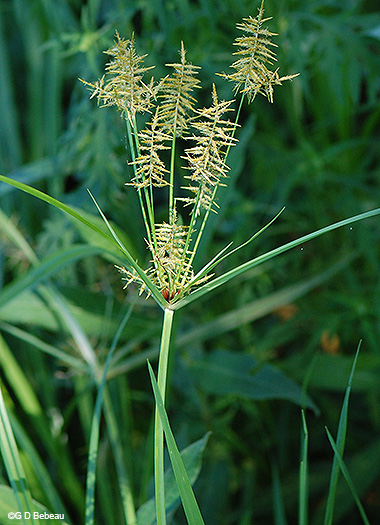

Above: Upper stem and inflorescence; note the long bracts at the base. Drawing from Britton, N.L., and A. Brown. 1913. An illustrated flora of the northern United States, Canada and the British Possessions. 3 vols. Charles Scribner's Sons, New York.
Below: Detail of a single spike with spikelets in flower and arranged around the rachis in a mostly perpendicular arrangement.
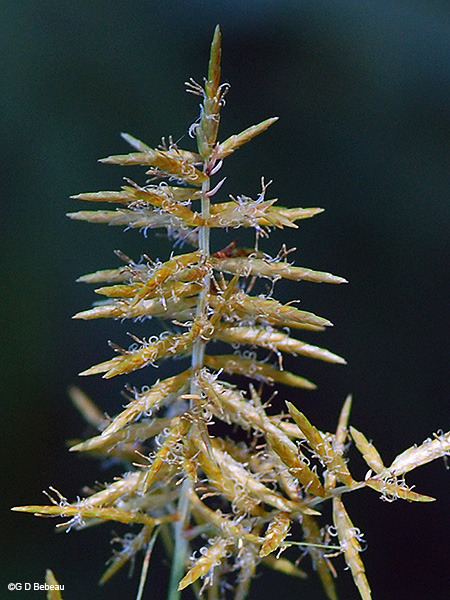
Below: 1st photo - maturing spikelets turning yellowish-brown. 2nd photo - the upper surface of a leaf blade showing the flanged 'V' shape.

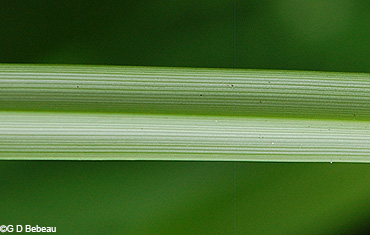
Below: 1st photo - sheath area of a leaf. 2nd photo - the inflorescence just starting to develop, with the 3 large base bracts in place.


Below: A more mature inflorescence with a basal spikelet and the stalks of the upper spikelets rising above it.
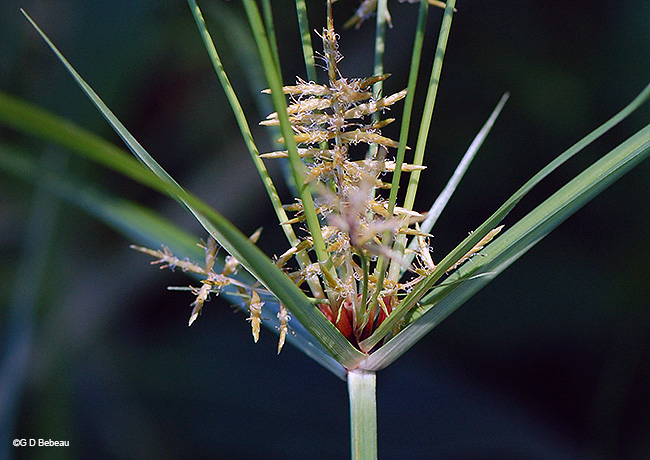
Below: The root system, which lacks a corm at the base of the stem.
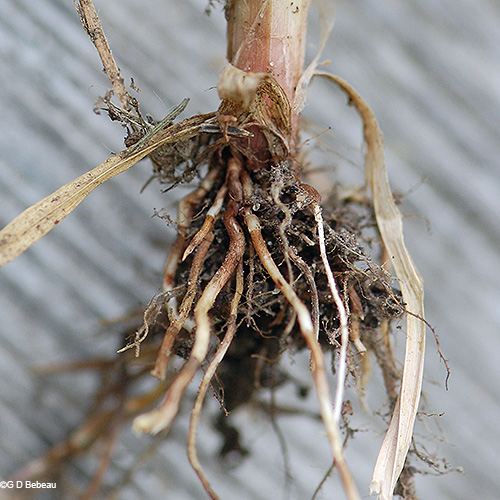
Yellow Nutsedge is one of over 150 sedges native to Minnesota. On the nutsedges in Cyperus, there are 13 in Minnesota, three of those introduced. This species one of those introduced into North America and to the state and is found in about half of the state's counties with most of the absences in counties of the western half. In North America it is found in all the lower 48 states of the U. S. except Montana and Wyoming and in Canada it is known in Ontario, Quebec, Saskatchewan and Manitoba.
There does not seem to be any record of Cyperus esculentus in the Garden. A general Cyperus sp. has been listed on past census reports. Eloise Butler noted finding Cyperus strigosus in the Garden in 1914 and of planting it in 1916, '24, and '32. Martha Crone did not list sedges on her 1951 census so we don't know whether either species was in the Garden at that time.
Return to -- Site Plan/Archive Index --or-- List of Common Plant Names -- or -- List of Scientific Names -- or --Home Page - - - Back to top.
References: Plant characteristics are generally from sources 1A, 32, W2, W3, W7 & W8 plus others as specifically applied. Distribution principally from W1, W2 and 28C. Planting history generally from 1, 4 & 4a. Other sources by specific reference. See Reference List for details.
 Identification booklet for most of the flowering forbs and small flowering shrubs of the Eloise Butler Wildflower Garden. Details Here.
Identification booklet for most of the flowering forbs and small flowering shrubs of the Eloise Butler Wildflower Garden. Details Here.
©2017
Friends of the Wildflower Garden, Inc. Text and photos are by G. D. Bebeau unless otherwise credited. "www.friendsofeloisebutler.org"
092920